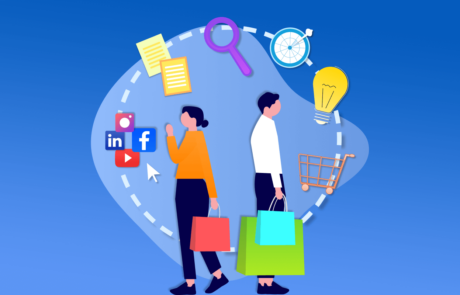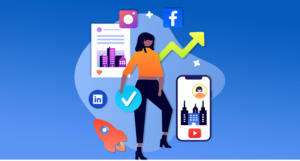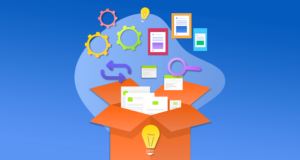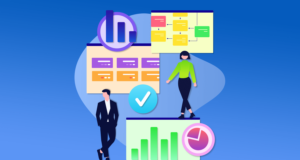5 Stages of the Customer Journey (With Marketing Strategies for Each)
Blog Categories:
Published:
January 23, 2024
Reading Time:
6 minutes

Have you ever found yourself pondering the intricacies of a customer's journey? Have you ever wondered how they evolve from mere awareness of a brand to becoming its loyal supporter? Well, it certainly doesn’t happen overnight.
You see, a customer's voyage through different stages of their buying journey involves awareness, consideration, decision-making, and post-purchase engagement. As a business, you must understand these stages well because you’ll need to create unique strategies for each stage.
In this article, we’ll discuss the five stages of the customer journey and unravel the mysteries behind successful marketing strategies.
So, let’s dive into it.

You see, a customer's voyage through different stages of their buying journey involves awareness, consideration, decision-making, and post-purchase engagement. As a business, you must understand these stages well because you’ll need to create unique strategies for each stage.
In this article, we’ll discuss the five stages of the customer journey and unravel the mysteries behind successful marketing strategies.
So, let’s dive into it.

KEY TAKEAWAYS
- The five stages of the customer journey are Awareness, Consideration, Decision, Post-Purchase, and Advocacy.
Stage 1: Awareness
In the Awareness stage, potential customers are introduced to your brand. They may not be familiar with your products or services yet. You should keep this in mind while creating a marketing strategy. Let’s understand how.


Marketing tips for the Awareness stage
- Focus on brand introduction: In the Awareness stage, the key objective is to introduce potential customers to your brand. You can do this in many ways—from billboard ads to collaborating with social media influencers.
- Create educational content: Develop content that addresses the informational needs of your target audience, like blog posts, FAQs, and how-to guides. And if you’re good with videos, well, then more power to you because a whopping 91% of customers want to see more videos from companies.
- Monitor awareness-related metrics: During this stage, focus on metrics like website traffic, social media reach, impressions, shares, and comments to gauge the success of your efforts in reaching the target audience. Don’t be too quick to count the number of sales yet.
- Build a strong brand: Consistently use branding elements like logos and colors to build a recognizable and memorable brand presence.

Stage 2: Consideration
During the Consideration stage, potential customers are actively exploring your products or services due to a higher level of interest. This is a critical phase where they're comparing options and seeking more in-depth information. Consider the following strategies to effectively make the most of this stage in the marketing journey.Marketing tips for the Consideration stage
- Content marketing: Unlike the content in the Awareness stage, where the goal is a broad introduction, content in the Consideration stage is deeper. For instance, whitepapers and case studies can provide valuable insights to potential customers and position your offerings as solutions to their needs.
- Comparison guides: Customers aren’t loyal to your brand yet—they’ll compare you to others. So, create comparison guides that highlight the unique features and advantages of your products or services compared to competitors.
- Email campaigns: Assuming that potential customers have been introduced to your brand and you have their basic contact information, you could set up targeted email nurturing campaigns to stay connected with them. Share relevant content, special offers, or exclusive insights to keep your brand at the forefront of their considerations.
- Testimonials: Showcase customer testimonials and success stories. Real-life experiences from satisfied customers build trust and can influence a new customer’s decision-making process.
Stage 3: Decision
Alright, this is when you, as a seller, could actually make a profit. In the Decision stage, potential customers are poised to make a purchase after narrowing down their options. This critical phase requires a strategic approach to provide the final push. Let’s understand how to effectively guide customers through this stage.Marketing tips for the Decision stage
- Build trust and provide clarity: Prioritize transparency and trust-building. Clearly communicate product benefits, features, and pricing to instill confidence in the decision-making process.
- Add a clear call-to-action (CTA): Provide a straightforward and compelling call-to-action to guide customers toward making the final purchase. Ensure that the steps for completing the purchase are intuitive and user-friendly.
- Make the payment process simple: Make sure customers have options to pay using all relevant methods such as debit cards, credit cards, and cash-on-delivery. For online shopping, make sure the e-commerce website is seamless and optimized for mobile. As far as brick-and-mortar stores are concerned, ensure there are adequate checkout counters.
- Discounts and promotions: As a final push to aid the purchase decision, offer compelling incentives such as limited-time promotions, discounts, or exclusive deals. These incentives serve as powerful motivators for customers ready to convert.
Stage 4: Post-Purchase
A customer’s journey isn’t over just after they pay you. Welcome to the Post-Purchase stage in which the focus is on maintaining customer satisfaction and encouraging loyalty. This phase is crucial for building long-term relationships and turning one-time buyers into repeat customers. Let’s discuss how to effectively navigate this stage.Marketing tips for the Post-Purchase stage
- Implement customer loyalty programs: Keep them coming back for more by introducing loyalty programs with exclusive benefits, rewards, or discounts for repeat purchases. Incentivize customers to stay engaged with your brand over time.
- Gather feedback: Don’t be out of touch. You should actively seek customer feedback through surveys, reviews, or direct communication channels. Use this feedback to create new products and offers, and also to enhance the overall customer experience.
- Create a customer support system: Did you know that 93% of customers may buy again if a company offers them excellent customer service? So, establish a responsive customer support system to address queries and concerns promptly. This is to ensure that the post-purchase experience is as positive as the pre-purchase experience.
- Use social media and email for connection: You should stay connected with customers through social media platforms and email newsletters. Share relevant updates, exclusive content, and personalized recommendations to maintain a meaningful relationship. Or better yet, hire a digital marketing consultant through Consultport and they’ll create a winning post-purchase strategy for you.

Stage 5: Advocacy
In the Advocacy stage, the focus is on turning satisfied customers into brand advocates who actively promote your products or services. Let’s discuss how it’s done.Marketing tips for the Advocacy stage
- Encourage user-generated content: Motivate satisfied customers to share their experiences through testimonials, reviews, and social media posts. Maybe even have a competition and select the best advocate for a reward? Feel free to be creative.
- Build online communities: Build a community platform or leverage existing social media groups where advocates can connect and share their experiences.
- Showcase advocacy stories: If you don’t want to wait for users to create content that glorifies your brand, you could highlight stories of customer advocacy through various channels yourself. For instance, this could be done by featuring case studies or interviews that illustrate how customers have benefitted from your brand.
- Implement referral programs: Referral programs could be introduced that reward both existing customers and their referrals. You should incentivize customers to recommend your products or services to their network.
Final Thoughts
And that brings us to the end of this article. Want to take your customer journey mapping and other marketing efforts to the next level? Here at Consultport, we have over 10,000 consultants in our network who have worked with top-tier consulting firms and blue-chip companies. Here’s a little sneak peek of what our marketing superstars can do.
Marketing Strategy Consultants: Allow our trusted consultants to define goals and objectives for your marketing department. With a strategic roadmap to success, you can elevate your marketing game with expert guidance.
Brand Strategy Consultants: Shape a distinctive brand identity with the help of our seasoned consultants. They will guide you in building a brand that stands out and leaves a lasting impression.
B2B Marketing Strategists: Turbocharge your B2B marketing efforts with our seasoned strategists. You can benefit from their years of consulting experience to craft impactful strategies that resonate in the business landscape.
Customer Journey Consultants: Now that you’ve already read about all the stages of a customer's journey in this article, you should 10X your knowledge and efficiency by bringing a customer journey consultant on board.
So, what are you waiting for?
Let us connect you with the brightest brains in the consulting industry.
Get in touch now.
Marketing Strategy Consultants: Allow our trusted consultants to define goals and objectives for your marketing department. With a strategic roadmap to success, you can elevate your marketing game with expert guidance.
Brand Strategy Consultants: Shape a distinctive brand identity with the help of our seasoned consultants. They will guide you in building a brand that stands out and leaves a lasting impression.
B2B Marketing Strategists: Turbocharge your B2B marketing efforts with our seasoned strategists. You can benefit from their years of consulting experience to craft impactful strategies that resonate in the business landscape.
Customer Journey Consultants: Now that you’ve already read about all the stages of a customer's journey in this article, you should 10X your knowledge and efficiency by bringing a customer journey consultant on board.
So, what are you waiting for?
Let us connect you with the brightest brains in the consulting industry.
Get in touch now.
Share This Story, Choose Your Platform!



